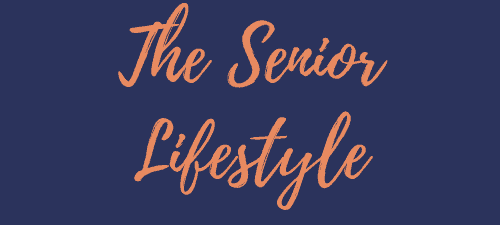A few months after she acquired “Wooly,” as he was known, my mother suffered an unrelated fall and was hospitalized. It fell to me to clean up her affairs, which included this lovely dog. I called my husband to test the waters and described what a beautiful animal this Maremma was. I stressed what a sweet nature he possessed. We already had a male shepherd at the time, and 2 male dogs in one space might have been a challenge. After a long pause, there was a plaintive “Pleeease…, do not bring that dog back with you.”
Ultimately, Wooly was adopted by a bachelor veterinarian on Prince Edward Island. Wooly now had 200 acres in which to run – a happy ending to my Mother’s accident – for the dog anyway…
Let’s look at the topic of seniors and dogs and the advantages of owning man’s furry best friend.
With Pet Ownership Comes Responsibility
Owning a pet as a senior enhances health and longevity. They truly are man’s best friend in more ways than one. But pet ownership is also a long-term commitment and full of responsibility.
Seniors must assess where they reside, their budget, their own capabilities and their temperament, and then try to find a match from the many breeds available.
Although miniature dogs come to mind as seniors downsize and move into smaller spaces, miniatures are not necessarily the first or only choice. Some larger dogs have temperaments entirely compatible to life with a senior citizen.
Consider Five of the Calmest Dog Breeds
1) The Labrador Retriever is the most popular of North American breeds. Many work as service dogs, given their friendly nature with people and other dogs. Although they do shed, they are easy to groom, eager to please, and easily trainable. That said, as with most dogs, early socialization and obedience classes are recommended. The high-energy Labrador Retriever would be best suited to an active senior, one dedicated to exercise and daily walks. Bonus alert: seniors who walk their dogs regularly have better heart health. Movement matters for both you and your pet! Scientists claim that senior pet owners have a 24% risk reduction for death from any caus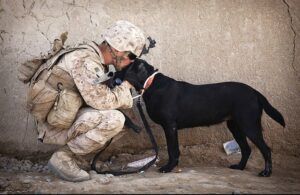 e.
e.
Height: up to 24.5″ for males and up to 23.5″ for a female
Weight: up to 80 lbs for a male and up to 70 lbs for a female
Life Expectancy: 10-14 years
Colors: Black, Chocolate or Yellow
2) The Golden Retriever is right up there with the Labrador Retriever in terms of its popularity and need for the company of its owner. Retriever puppies are adorable. These dogs are intelligent and friendly and love people. Their love of people does not render them great guard dogs, though.
Active seniors would make ideal owners as this is a high-energy pooch. Golden Retrievers are strong swimmers and are used as sporting dogs. They also work as guide dogs for the blind and are employed in search and rescue operations. Goldens do she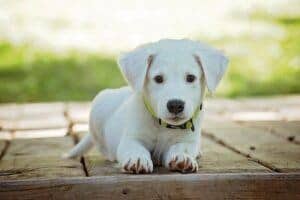 d and require regular grooming. Early socialization and obedience classes are recommended.
d and require regular grooming. Early socialization and obedience classes are recommended.
Height: 23-24 ” for a male and 21.5-22.5 ” for a female
Weight: up to 70 lbs for a male and up to 65 lbs for a female dog.
Life Expectancy: 10-12 years
Colors: Cream, Light or Dark Golden
3) Pugs are notably friendly smaller dogs well suited to families. They are described as robust happy dogs, loving and lovable. Potential skin problems on their face require attention with daily cleansing. Owners claim their pugs are the ideal housedog. They thrive in both urban and rural environments, with children or senior citizens. Pugs tend to be foodies so attention to portion control and exercise is mandatory. They do best in moderate weather, neither too hot nor too cold. 
Height: 10-13 ”
Weight: 14-18 lbs.
Life Expectancy: 13-15 years
Colors: Silver, Apricot or Black
4) The Newfoundland Dog is a large, powerful dog that has earned its reputation as a great babysitter for children. It is a superb swimmer known for its innate lifesaving ability. Although the size can be intimidating, the Newfoundland dog has a gentle temperament.
Newfies need regular exercise and are easily trainable. A dog this size would not be appropriate in a retirement home setting, but a single-family dwelling with a yard would work. Because of its size, early socialization and obedience training are recommended. Brushing 3 X a week is recommended so that their coat does not mat.
Height: 28″ for a male and 26 inches for a female 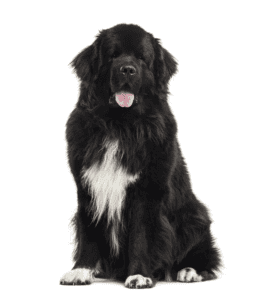
Weight: 130-150 lbs for a male and 100-120 lbs for a female
Life Expectancy: 9-10 years.
Colors: Gray, Brown, Black
5) The Great Dane
Finally, the dog’s gentle nature belies the intimidating size of the Great Dane. Danes are patient with children and demonstrate a sweet disposition. They’ve proven that they can be wonderful family pets. That said, if this dog senses danger to its family, it will put up a formidable challenge.
Because of its size, this breed needs to be socialized early and participate in obedience training. It is a shedder and requires regular brushing. It’s definitely another breed unsuited to living in a retirement home but a gentle pet for any senior living in a single-family home with a yard. Exercise is recommended 3 X per day. Because of their curious nature, Danes should be leashed at all times when outside their yard 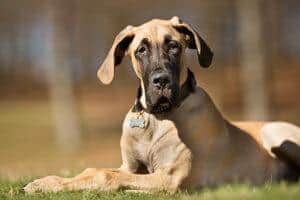 unless they are in a secure setting.
unless they are in a secure setting.
Height: 30-32 ” for a male and 28-30″ for a female
Weight: 140-170 lbs for a male and 110-140 lbs for a female
Life Expectancy: 8-10 years
Colors: Numerous – black, blue, brindle fawn, chocolate, silver, etc.
When Smaller Dogs Are the Only Option:
We’ve already mentioned the Pug, but several other small dogs are suited to living in a smaller space. These include:
- The Papillon
Known for its intelligence, and although it appears fragile, this petite dog is athletic and hardy. These dogs are loyal companions and friendly. They can reside in any climate and are suited to either rural or city life.
Noted performers and 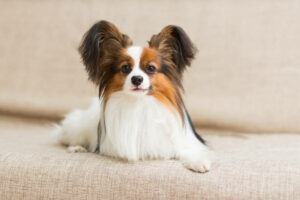 consistent winners in agility competitions, the Papillon would suit any active senior. Plus, the grocery bill for this dog would be manageable, given their size and weight.
consistent winners in agility competitions, the Papillon would suit any active senior. Plus, the grocery bill for this dog would be manageable, given their size and weight.
Height: 8-11 inches
Weight: 5-10 lbs
Life Expectancy: 14-16 years
Colors: Numerous – White & black, lemon, red, sable, fawn, etc.
- The Pomeranian
Tiny but a good watchdog when necessary, the Pom acts like any big dog would. Easily trained, alert, and smart, this little dog enjoys exercise indoors or outdoors and can live in any city or suburb. Housebreaking can be a challenge with this breed, so patience and consistency are required. The Pom requires grooming and regular exercise.
Because of their size, they can be a target for winged predators and 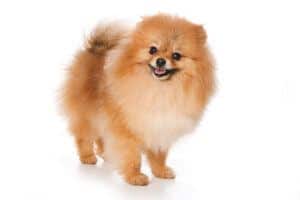 should never be allowed outdoors on their own. They’re also escape artists, and any fenced yard should be checked for escape ports and be fortified.
should never be allowed outdoors on their own. They’re also escape artists, and any fenced yard should be checked for escape ports and be fortified.
Height: 6-7″
Weight: 3-7 lbs
Life Expectancy: 12-16 years
Colors: There are many available, but the most common are orange or red
- The Shih Tzu
Originating in China, this regal little dog was the go-to house pet for most of the Ming Dynasty and carries itself in accordance with its lineage. Nicknamed the “Lion Dog,” Shih Tzus is a loving companion and good with children. This dog is basically a house dog requiring minimal exercise and is better suited to any senior with mobility issues.
The breed can be a challenge to housebreak and will use charm to get its way. Obedience training is recommended early on. Once again, if you wish to keep your grocery bill down, t hese small dogs can be a solution.
hese small dogs can be a solution.
Height: 9-10.5″
Weight: 9-16 lbs.
Life Expectancy: 10-18 Years
Colors: Numerous, but Gold, Black, White, Red, or their combination are common.
- The Bichon Frise
Believed to have originated in the Canary Islands, this little dog is charming, beautiful and intelligent. This is a friendly canine when it comes to other dogs and children. They can be watchdogs but prefer to get along with people. Ideal city dogs, this breed is highly trainable, with the exception of housebreaking, which can be a challenge.
They require mid-level exercise and regular play sessions with their owner. The Bichon Frise would do well living in a house with a fenced backyard. As with most dogs, early socialization and training is recommended. One problem is that they are fast; an escape could present a problem for any slow-moving senior. Grooming is simple, with brushing recommended once daily for this low shedder.
.Height: 13-16 ”
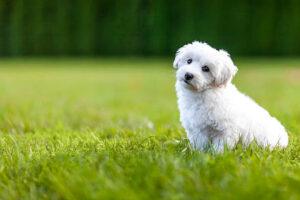
Weight: 12-18 lbs
Life Expectancy: 14-15 years
Color: White
- The Yorkshire Terrier
One of the most popular small dogs, the Yorkie, is known to be feisty and sometimes self-important and bossy. These dogs are favorites for folks living in urban centers and are good watchdogs. Daily brushing and weekly baths are recommended. That said, this dog is a low-shedder. Yorkies need 2 short walks a day and enjoy obedience and agi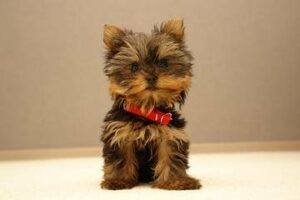 lity classes. The breed should be socialized early and can work as a therapy dog.
lity classes. The breed should be socialized early and can work as a therapy dog.
Height: 7-8″
Weight: 7 lbs.
Life Expectancy: 11-15 years
Colors range from black and tan, black and gold, blue and gold, and blue and tan
Main Considerations In Choosing A Furry Friend
Because pet ownership should be considered a long-term commitment, choosing the right breed for your lifestyle is imperative. Consider your ability to exercise a dog regularly, as most do require a daily outing. Also, consider the energy level of the dog. Is it compatible with your ability to keep up?
What temperament do you want in a pet? Are you acquiring a pet for security or companionship – or both? Will you purchase pet insurance early on to cover any veterinarian bills because they will become a fact of life? Or do you have the means to pay as you go?
Are you willing to dedicate the necessary time and effort to train and socialize your dog? This is your responsibility, and there might be consequences if you don’t take it seriously. Does your budget allow for all this and then provide good quality food for this animal?
Research the Breed Thoroughly
Quality dog food is a necessary investment if you want a healthy dog. If you don’t provide a good quality diet for your dog, the money you save might be spent later when you have to visit the vet as a result of dietary issues, skin problems, or allergies.
You should thoroughly research any breed you consider making a member of your family. Check the temperament, known health problems, energy level, and life expectancy. And don’t take on any animal if you’re not fully committed to becoming their forever home.
All that said, there are significant benefits to pet ownership, one being better heart health.

Consider A Rescue
Don’t buy from a puppy mill. Doing so will only perpetuate animal cruelty. Visit your local SPCA or animal shelter and seriously consider a rescue. Don’t choose a dog you do not feel a connection with. Yes, there is something to be said for chemistry, even with a dog.
Always commit to treating and training your dog with patience and kindness. Be realistic about the amount of space you can provide this animal and whether or not the breed is suited to your domicile.
Do commit to providing your dog with adequate exercise.
Train your pet with positive reinforcement and treats rather than aggressive correction. Realize that pets cost money but that they do give a lot in return. Do know that you will have a furry friend for life – for some people, even a family member – one who will be there for you through thick and thin and who will see you as their whole world.
